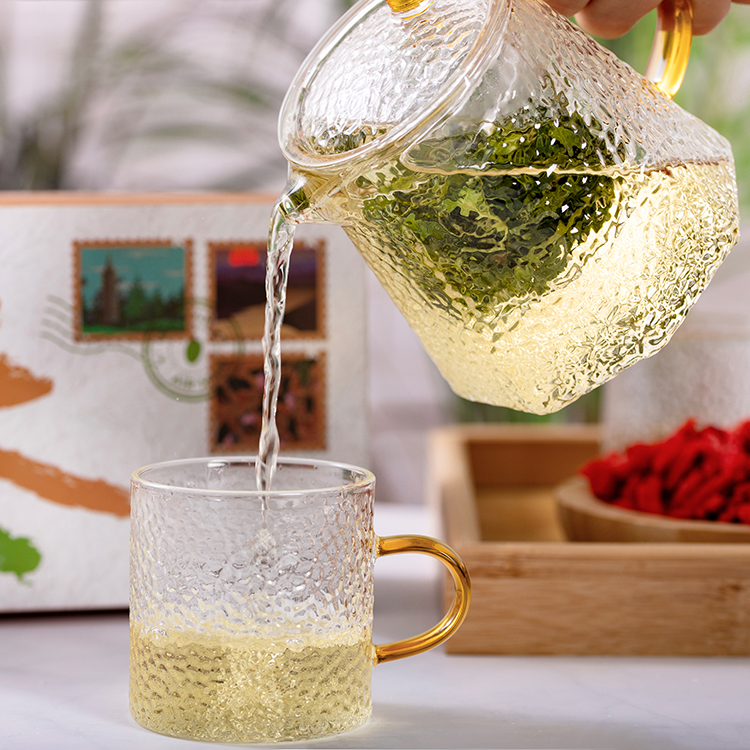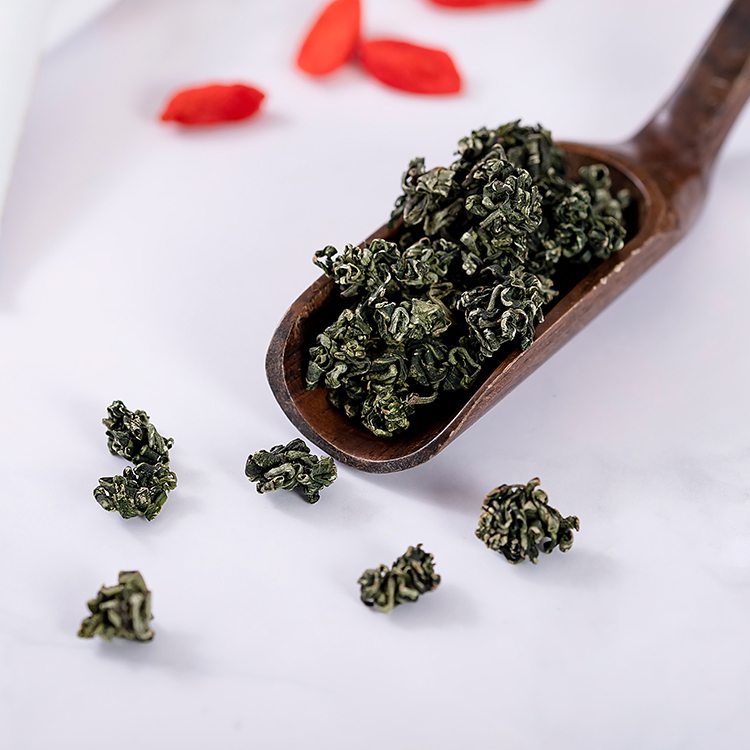What are the health functions of wolfberry bud tea?
1) Antioxidant activity
Animal experiments show that wolfberry bud tea can improve the learning and memory ability of mice, enhance endurance and significantly increase the body's antioxidant capacity.
2) Antihypertensive and hypolipidemic activity
Clinical studies have shown that patients with hyperlipidemia after drinking wolfberry bud tea (three times a day, each time taking 2g bud tea and brewing with 600mL water) for 4 months, the serum total cholesterol level, triglyceride level, MDA level and low density lipoprotein level decreased , Indicating that wolfberry bud tea has the effect of regulating blood lipids and enhancing the body's antioxidant capacity.
3) Protective effect of skin light damage
The total flavonoids in wolfberry leaves regulate the activities of catalase, glutathione peroxidase, and SOD in the skin tissues of the body to effectively remove excess free radicals generated in the skin tissues, thereby enhancing the skin tissues` UV radiation Resistance.
4) Liver protection
Animal experiments show that wolfberry leaves have a certain preventive and protective effect on alcoholic fatty liver.
What are the nutritional value of wolfberry bud tea?
The content of biologically active ingredients in the buds and leaves of wolfberry is more consistent with that of wolfberry fruits, and the content of certain biologically active substances (polyphenols) is even higher than that of wolfberry fruits, which has high health benefits and nutritional value.
1) Polyphenols, flavonoids, carbohydrates, etc.
The content of polyphenols in wolfberry bud tea is 6.32%, flavonoids 1.88%, total sugars 4.59%, and protein 1.53%. The amino acid content is 1.89%, which is relatively abundant. The content of fructose in wolfberry bud tea tea soup was 31.44 mg/g, and the content of sucrose was 10.99 mg/g. No glucose was detected. Polyphenols are one of the most important active substances in wolfberry bud tea. The main polyphenols in wolfberry bud tea are chlorogenic acid, neochlorogenic acid and rutin. The inhibitory effects of wolfberry bud tea and various extracts are stronger than that of the positive control commercially available acarbose.
2) Protein
Wolfberry leaves contain almost the same amount of protein as meat, which is a good source of protein, and wolfberry leaves do not contain cholesterol in meat foods that can easily cause cardiovascular and cerebrovascular diseases, so it has good edible and medicinal value. Lycium barbarum leaves contain 19 kinds of amino acids, the total amount can reach nearly 9.05%, including all essential amino acids. The free amino acids in wolfberry leaves are easily digested and absorbed by the human body.
3) Minerals
Lycium barbarum leaves are rich in trace elements that are closely related to human health. Mineral elements such as zinc, iron, copper, magnesium, calcium, potassium and other elements are rich in content, which provides a certain anti-aging and prevention and treatment of coronary heart disease for wolfberry leaves. Calcium is one of the most important trace elements in the human body. Calcium is closely related to human osteoporosis, diabetes, hypertension and other diseases. Research results show that the calcium content in wolfberry leaves is as high as 59mg/g, which is 52 times that of wolfberry and about 10 times that of green tea. At the same time, the elements of Fe, P, Na, Mg in wolfberry leaves are also higher than that in wolfberry leaves.
4) Vitamins
Vitamins are important biologically active substances in wolfberry leaves, and the contents of ascorbic acid, niacin, thiamine, and riboflavin are higher than those of wolfberry fruits and vegetables such as tomatoes, cucumbers, and Chinese cabbage. The content of niacin in wolfberry leaves is outstanding. Niacin is the most demanded B vitamin in the human body. The content of niacin in wolfberry leaves is 0.1592mg/g, which is more than 20 times that of ordinary vegetables. Thiamin is usually involved in the catabolism of carbohydrates in the form of coenzymes in the body, and plays the role of promoting intestinal peristalsis, increasing appetite, and protecting nerves in the body. According to research, the content of thiamine in wolfberry leaves is extremely rich. The content is as high as 0.00242mg/g, which is about 10 times that of cabbage. Vitamin C plays an irreplaceable role in the metabolism of the human body. It has important functions such as anti-cancer, enhancing human resistance, protecting the liver, and detoxifying. Studies have determined that the content of vitamin C in wolfberry leaves reaches 0.3 mg/g, which is about that of wolfberry. 1.7 times, much higher than cucumbers, cabbage, tomatoes and other vegetables. Fatty substances are also an important part of the chemical composition of wolfberry. Studies have shown that the crude fat content in fresh wolfberry fruits can reach 12%, of which the content of unsaturated fatty acids reaches 61.8%.
goji berry bud tea,wolfberry bud tea,goji bud tea Ningxia Red Power Goji Co., Ltd. , https://www.redpowergoji.com
In China, the hidden dangers of health and safety due to production environment problems account for most of the proportion. In terms of processing, the food processing and production fields have low barriers to entry, and they are processed by multiple retailers and small households. Of the more than 500,000 food production enterprises in the country, more than 400,000 are small businesses with less than 10 employees. The supervision is similarly wide-ranging.
Food expert Zhou Liqin suggested that changing the food industry to unilaterally pursue economic benefits, while ignoring the current status of production of sanitary pollution; changing the existing sterilization mode of the production environment, and vigorously developing new workshop sterilization technology; using the minimum of existing domestic production technology The economic input, the greatest change in the health conditions of the production environment, the food hygiene quality control in an acceptable range.
Food safety will be a hot spot for all walks of life and consumers in the long run. Although the maintenance of food safety is not something that a single department can do, production companies should bear the main responsibility for them. “Safe foods are produced and not supervised.†After all, food safety responsibility is the main body of the company. Food appears. The foundation of security issues is generally also in the enterprise.
With the development of the food industry, there are more and more types of food, and the production processes vary widely. Food production and processing operations may have hidden dangers in food safety. A small mistake, such as microorganisms exceeding the standards, can sometimes trap the entire industry. "disaster".
However, no matter how the production process changes, strict disinfection and sterilization are still the main means for food production companies to control microorganisms to exceed the standard. Advanced, high-efficiency, and environmentally-friendly disinfection technology can bring about a multiplier effect for businesses.
According to Zhou Kangli, engineer of Shanghai Kangjiu Disinfection Technology Co., Ltd., in recent years, major breakthroughs have been made in the field of food sterilization and sterilization technology, and the NICOLER sterilization technology using the principle of plasma sterilization has been developed to overcome traditional disinfection and sterilization technologies. Can not be the problem of man-machine synchronization operation, from a number of enterprise application tests show that the effect is obvious, in the 45 square meters of internal packaging or filling workshop opened a "NICOLER food dynamic disinfection machine" 60 minutes later, the workshop air deposition bacteria ≤ 15 CFU/dish • 30 minutes, bacteriostatic bacteria in the air ≤800 cells/m3, air cleanliness ≥300,000, fully in line with corporate and national standards.
Food dynamic sterilization technology is the latest NICOLER three-level bidirectional plasma electrostatic field working principle. Utilizing high-voltage direct current pulses makes the plasma electrostatic field produce a reverse electricity effect, generates a large amount of plasma to decompose and kill bacteria, and then passes through the filter and electrostatic network. The secondary sterilization and purification of components, a large number of plasma quickly covered in the surface of pipes, tools and other objects, inhibit bacterial growth and reproduction, not only kill harmful bacteria and bacteria in the air, but also effectively kill their own bacteria (metabolism ), to maintain a controlled environment of "sterile clean."
Therefore, it is important to increase the intensity of food safety sampling. It is more important for food companies to improve their safety awareness and to upgrade their food safety equipment. Only by treating both the symptoms and the symptoms, internal and external forces can achieve the desired results, so as to produce safer and more secure products. Food is provided to a wide range of consumers. 

Food safety has received a great deal of attention. In the final analysis, we must pay attention to the production process.
In 2011, public security agencies at all levels across the country have detected more than 5,200 food safety crimes and arrested more than 7,000 people; Procuratorial agencies at all levels have arrested 1,801 suspicious individuals for selling poisonous and harmful foods, and filed public prosecutions. People; People's courts at all levels have jointly processed and sold 333 cases of toxic and harmful foods, produced and sold foods that did not meet health (safety) standards, and 416 were criminally punished. 286 people were sentenced to fixed-term imprisonment, life imprisonment, and death. Food safety supervision departments at all levels investigated and dealt with more than 18,000 cases of illegal foods.